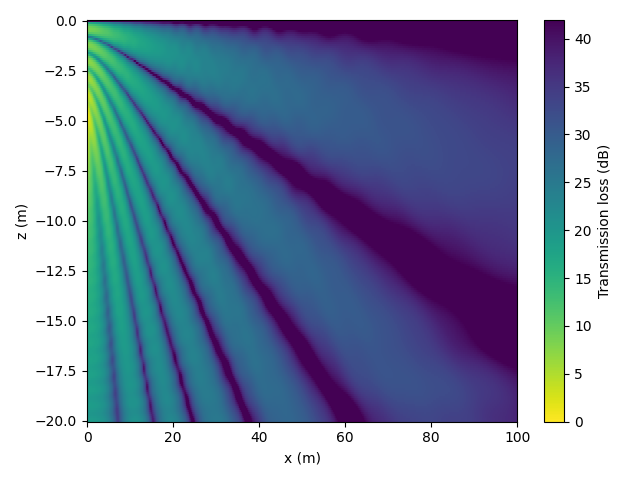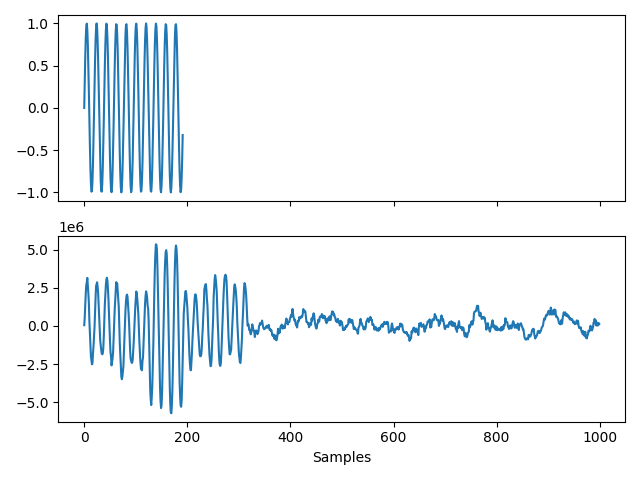7 element Vector{RayArrival}:
∠ -2.9° 0⤒ 0⤓ ∠ 2.9° | 65.06 ms | -40.0 dB ϕ 0.0°↝
∠ 8.5° 1⤒ 0⤓ ∠ 8.5° | 65.71 ms | -40.1 dB ϕ 180.0°↝
∠-14.0° 0⤒ 1⤓ ∠-14.0° | 66.98 ms | -62.6 dB ϕ 170.9°↝
∠ 19.3° 1⤒ 1⤓ ∠-19.3° | 68.85 ms | -74.3 dB ϕ -23.4°↝
∠-24.2° 1⤒ 1⤓ ∠ 24.2° | 71.26 ms | -80.4 dB ϕ-145.6°↝
∠ 28.8° 2⤒ 1⤓ ∠ 28.8° | 74.16 ms | -73.5 dB ϕ 10.8°↝
∠-33.0° 1⤒ 2⤓ ∠-33.0° | 77.50 ms | -100.7 dB ϕ-167.2°↝Calling from Python
Installation
While UnderwaterAcoustics.jl is written in Julia, it can be called from Python using JuliaCall. For this, we need to install the juliacall package. For some of the examples below, we will also need to numpy and matplotlib, so let’s install them as well:
pip install juliacall numpy matplotlib
Next, we will need to install UnderwaterAcoustics.jl and optionally Plots.jl. To do this, start a Python interpreter and run the following commands:
import juliapkg
juliapkg.add("UnderwaterAcoustics", "0efb1f7a-1ce7-46d2-9f48-546a4c8fbb99")
juliapkg.add("Plots", "91a5bcdd-55d7-5caf-9e0b-520d859cae80")While Plots.jl is not necessary if you plan to use matplotlib for plotting, we install it here to demonstrate its use from Python. The plot recipes for Plots.jl that come with UnderwaterAcoustics.jl are very convenient and work nicely if you using Plots.jl from Python. If you use matplotlib, you will need to write your own plotting code based on the data returned from UnderwaterAcoustics.jl. We will show examples of both approaches below.
Getting started
Now we are ready to use UnderwaterAcoustics.jl from Python. To load the package from Python:
from juliacall import Main as jl
jl.seval("using UnderwaterAcoustics")
Let’s start with a simple example similar to the one shown in Quickstart:
env = jl.UnderwaterEnvironment(bathymetry=20, seabed=jl.SandyClay)
pm = jl.PekerisRayTracer(env)
tx = jl.AcousticSource(0.0, -5.0, 1000.0)
rx = jl.AcousticReceiver(100.0, -10.0)
rays = jl.arrivals(pm, tx, rx)
We can display the ray arrivals:
raysor plot them using Plots.jl:
jl.seval("using Plots") # python doesn't support "!", so we create
jl.seval("plot_add = plot!") # an alias plot_add for plot! in Julia
p = jl.plot(env, xlims=(-10,110))
jl.plot_add(tx)
jl.plot_add(rx)
jl.plot_add(rays)
jl.display(p)We can also get the acoustic field or the transmission loss:
jl.acoustic_field(pm, tx, rx)0.011324625487986332 + 0.013441467920062827imjl.transmission_loss(pm, tx, rx)35.101536894459066We can also create a grid of receivers and compute the acoustic field over the grid:
rxs = jl.AcousticReceiverGrid2D(jl.range(1.0, 100, step=0.1), jl.range(-20, 0, step=0.1))
x = jl.transmission_loss(pm, tx, rxs)
We can display the transmission loss grid or plot it using Plots.jl:
x991×201 Matrix{Float64}:
19.1283 19.2328 19.5428 19.8492 … 8.82646 11.1099 16.4209 87.1227
19.1329 19.2373 19.5471 19.8536 8.87496 11.1689 16.4855 87.123
19.1381 19.2424 19.552 19.8586 8.92702 11.2323 16.5549 87.1233
19.1442 19.2483 19.5577 19.8643 8.9824 11.2997 16.6288 87.1237
19.151 19.255 19.5641 19.8709 9.04085 11.3708 16.7068 87.124
19.1587 19.2626 19.5715 19.8784 … 9.10213 11.4454 16.7886 87.1244
19.1674 19.2712 19.5799 19.8869 9.16604 11.5232 16.8739 87.1248
19.1772 19.2809 19.5893 19.8965 9.23241 11.604 16.9625 87.1253
19.1882 19.2918 19.6 19.9073 9.30109 11.6875 17.0541 87.1258
19.2005 19.3039 19.6119 19.9194 9.37202 11.7737 17.1485 87.1263
⋮ ⋱ ⋮
37.3745 37.4387 37.4769 37.4921 57.8844 61.3578 67.2495 98.1624
37.4079 37.4741 37.5144 37.5317 57.9056 61.3788 67.2688 98.1837
37.4422 37.5104 37.5527 37.5722 57.9268 61.4001 67.2893 98.205
37.4774 37.5476 37.592 37.6136 … 57.9481 61.4217 67.3109 98.2263
37.5134 37.5857 37.6321 37.6558 57.9693 61.4435 67.3336 98.2477
37.5504 37.6247 37.6732 37.6989 57.9903 61.4655 67.3573 98.269
37.5882 37.6646 37.7151 37.7428 58.0112 61.4877 67.3819 98.2904
37.6269 37.7053 37.7578 37.7876 58.0319 61.5099 67.4075 98.3118
37.6665 37.7469 37.8014 37.8332 … 58.0524 61.5322 67.4338 98.3333p = jl.plot(env, xlims=(0,100))
jl.plot_add(rxs, x)
jl.display(p)Plotting with matplotlib
If you prefer to use matplotlib for plotting, you can use the data returned from UnderwaterAcoustics.jl to create your own plots:
import numpy as np
import matplotlib.pyplot as plt
xloss = np.flipud(np.array(x).transpose())
nz, nx = xloss.shape
x_axis = np.linspace(0, 100, nx)
z_axis = np.linspace(0, -20, nz)
plt.figure()
mesh = plt.pcolormesh(x_axis, z_axis, xloss, shading='auto', cmap='viridis_r', vmin=0, vmax=42)
cbar = plt.colorbar(mesh)
cbar.set_label('Transmission loss (dB)')
plt.xlabel('x (m)')
plt.ylabel('z (m)')
plt.tight_layout()
plt.show()
More propagation models
Using other acoustic propagation models such as Bellhop, Kraken, etc is a breeze. During installation, include the relevant Julia packages. For example, to use Bellhop or Kraken, include AcousticToolbox.jl:
import juliapkg
juliapkg.add("AcousticsToolbox", "268a15bc-5756-47d6-9bea-fa5dc21c97f8")To use models like Bellhop, Kraken, etc, you will NOT need to install the FORTRAN binaries separately. They are automatically installed when you install the relevant Julia packages.
To use the propagation models from AcousticToolbox.jl:
from juliacall import Main as jl
jl.seval("using UnderwaterAcoustics")
jl.seval("using AcousticsToolbox")
bathy = jl.SampledField(np.array([200, 150]), x=np.array([0, 1000]))
ssp = jl.SampledField(np.array([1500, 1480, 1495, 1510, 1520]), z=jl.range(0, -200, step=-50), interp=jl.CubicSpline())
env = jl.UnderwaterEnvironment(bathymetry=bathy, soundspeed=ssp, seabed=jl.SandyClay)
pm = jl.Bellhop(env)
tx = jl.AcousticSource(0.0, -5.0, 1000.0)
rx = jl.AcousticReceiver(100.0, -10.0)
rays = jl.arrivals(pm, tx, rx)6 element Vector{RayArrival}:
∠ -9.0° 0⤒ 0⤓ ∠ -3.8° | 672.12 ms | -60.5 dB ϕ 0.0°↝
∠-13.2° 0⤒ 1⤓ ∠-14.3° | 677.43 ms | -87.3 dB ϕ 138.1°↝
∠ 10.3° 1⤒ 0⤓ ∠ 6.3° | 680.38 ms | -60.3 dB ϕ 180.0°↝
∠ 16.2° 1⤒ 1⤓ ∠-18.9° | 693.31 ms | -89.9 dB ϕ-149.1°↝
∠-20.9° 1⤒ 1⤓ ∠ 24.4° | 724.26 ms | -89.7 dB ϕ-165.2°↝
∠ 24.9° 2⤒ 1⤓ ∠ 29.0° | 749.86 ms | -87.1 dB ϕ 7.5°↝jl.seval("using Plots")
jl.seval("plot_add = plot!")
p = jl.plot(env, xlims=(-10,110))
jl.plot_add(tx)
jl.plot_add(rx)
jl.plot_add(rays)
jl.display(p)Channel modeling
We can also access the channel modeling API from Python. For example, we can obtain a channel from a propagation model:
env = jl.UnderwaterEnvironment(bathymetry=20, seabed=jl.SandyClay)
pm = jl.PekerisRayTracer(env)
tx = jl.AcousticSource(0.0, -5.0, 1000.0, spl=170)
rx = jl.AcousticReceiver(100.0, -10.0)
fs = 192000
ch = jl.channel(pm, tx, rx, fs, noise=jl.RedGaussianNoise(0.5e6))
We can then create a signal and pass it through the channel:
import numpy as np
x = np.sin(2 * np.pi * 10000 * np.arange(0, 0.001, 1/fs))
y = jl.transmit(ch, x, fs=fs) # returned signal is a Julia SampledSignal object
y = np.array(y) # so we convert it to a numpy array
and plot it using matplotlib:
import matplotlib.pyplot as plt
fig, (ax1, ax2) = plt.subplots(2, 1, sharex=True)
ax1.plot(x)
ax2.plot(y[:1000])
ax2.set_xlabel("Samples")
plt.tight_layout()
plt.show()